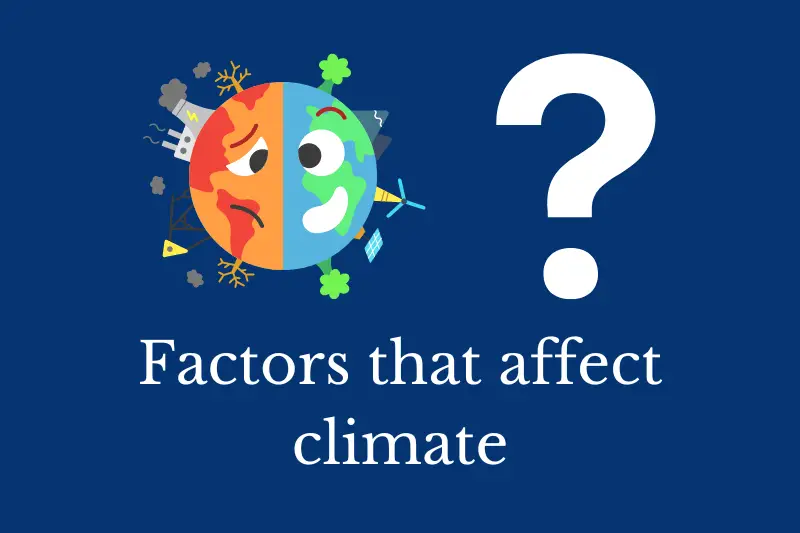Climate is the normal pattern of weather conditions in a region over a long period of time. Weather measurements such as temperature, type and amount of precipitation, wind speed, relative humidity, and atmospheric pressure are accumulated over 30 or more years and then averaged to determine a region’s climate. Here are some of the factors that affect climate:
Factors that affect climate
Climate in a region is affected by a variety of factors, including:
- Latitude.
- Ocean currents.
- Air masses.
- Elevation.
- Land formations.
- Nearness to large bodies of water.
Let’s now take a look at how each of these factors affect climate:
How does latitude affect climate?

The distance from the equator affects the temperature in a region. Temperatures tend to be lower the farther a region is from the equator.
Because of the curvature of the Earth, at high latitudes the Sun’s rays are hitting at an angle.
This means they have to pass through more atmosphere, and are spread out over a greater area. Less energy reaches the Earth’s surface, resulting in lower temperatures.
As well, the presence of snow and ice at the poles causes the Sun’s energy to be reflected instead of absorbed, a phenomenon called the albedo effect. This also contributes to the colder temperatures at high latitudes.
How do ocean currents affect climate?

Ocean currents carry large amounts of water in circular patterns around the oceans. Air above the ocean currents will warm or cool to that of the water below.
Ocean currents that start in warm regions but move to cooler ones will carry warm water and air to the cooler region.
Conversely, cool currents will bring cooler water and air to warmer regions. This effect tends to keep coastal areas at consistent temperatures.
How do air masses affect climate?
Air masses are vast pockets of air that take on the climate of the region below it, whether it is land or water.
Air masses that form over water tend to be humid while those that form over land tend to be dry.
Masses formed near the equator are warm while those that form closer to the poles are cold. Warm air masses rise up, causing low air pressure while cool ones stay low and cause high air pressure.
As air moves from high to low pressure regions, these differences in atmospheric air pressures cause wind.
How does elevation affect climate?

Typically, as elevation (or altitude) increases, temperatures drop.
This is because, at higher elevations, atmospheric pressure decreases and air expands. This thinner air cannot hold as much heat because the particles are farther apart.
There is also less oxygen. The air cannot hold as much water vapour and it condenses to form precipitation, usually rain or snow.
Land and climate
Large changes in land elevation, such as mountains, force air masses up to higher elevations. This cools the air and makes it less dense.
As the atmospheric pressure drops, water vapour in the air condenses and forms precipitation, so the windward sides of mountains receive a significant amount of precipitation.
Once the air has passed over the mountain, the air comes back down and warms up, becomes denser and can hold more water vapour, making the leeward side of the mountain very dry.
How do large bodies of water affect climate?
Large bodies of water heat up and cool down more slowly than land. This causes temperatures to be more moderate in areas near water.
As these areas get colder in the winter, the water cools off more slowly, keeping temperatures warmer in the winter.
Equally, as temperatures rise in the summer the water is slow to warm up, keeping temperatures cool.
Locations at the centre of continents, which are far from bodies of water, experience considerably larger temperature changes between summer and winter.
Areas near water also experience more precipitation because of the water vapour in the air.
Climate factors summary
To determine the climate for a region, all of these factors have to be considered as they pertain to that area – its location on Earth, its altitude, and its nearness to water and various landforms.
Each climate region on Earth is a unique combination of these factors, from deserts and tundras to rainforests and savannas, and everything in between.








